We invite beginners of all ages and experienced birders to our introductory walks on the first Saturday of each month. Waterfowl, passerines and raptors can all be found at Turtle Bay and the surrounding area which includes the Sacramento River and surrounding riparian habitat. The walks begin at 9am and meet in the parking lot near the Monolith structure at the South end of the Sheraton Hotel. Binoculars and field guides will be available to loan. Call Roberta Winchell, 530-945-8342, for more information.
Tag Archives | raptors
Osprey Nesting Platform Install
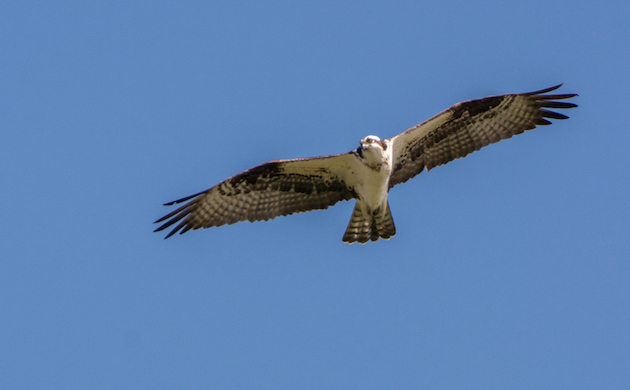
The Osprey (Pandion haliaetus) at Anderson River Park in Shasta County have been nesting atop a soccer field light stand for over 17 years. The problem is that they build the nest right on top of the field lights. This becomes an issue when, every four or five years the light bulbs need to be replaced and the nest can be destroyed in the process.
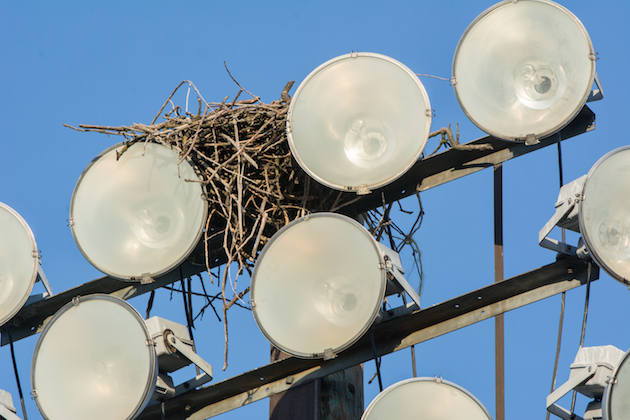
One of my wildlife rehabber friends had received a legacy gift and contacted me regarding the prospect of building a nesting platform to place at the top of the utility pole. This would allow the Osprey to safely nest above the bank of lights, thereby keeping their nest intact year after year, with no interference from the maintenance crew.
I, of course said, “what a great idea!” I found an excellent plan for the platform (shown below) from the International Osprey Foundation and built it in less than a day. It is a 40 x 40 inch box which I modified using all 2 x 6 inch pressure treated lumber.
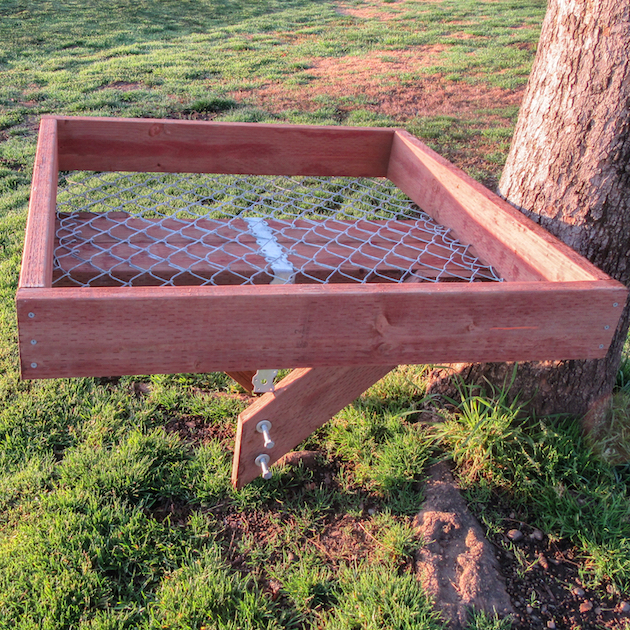
Before building the platform I contacted the Anderson City Public Works department to discuss the possibility of actually putting up the platform and got the OK. We obviously wanted to get it up before the Osprey arrived and were able to install it on January 31st.
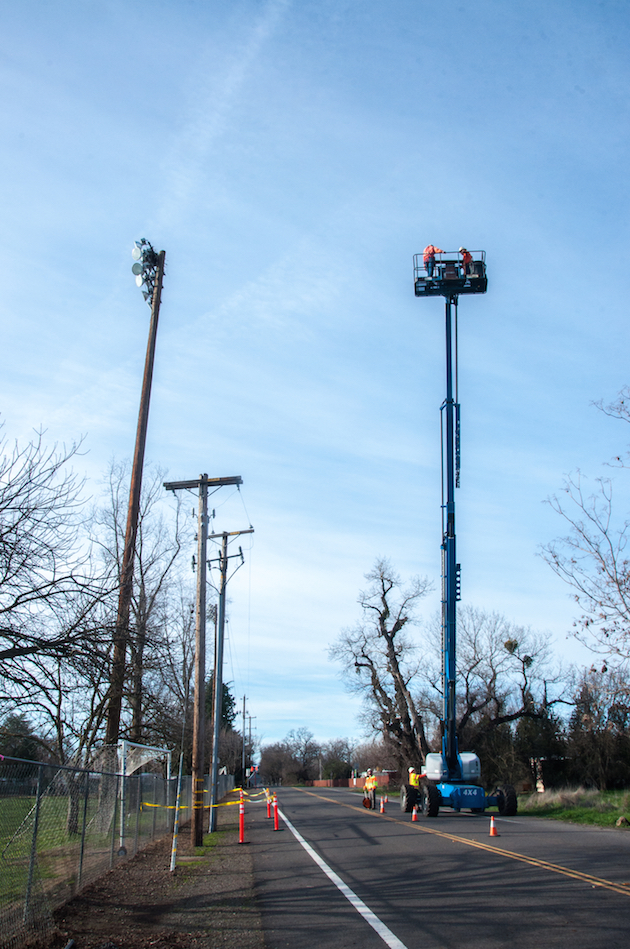
This is an 86 foot utility pole so a lift was rented and the excellent workers from the City of Anderson Public Works department generously gave their time and expertise to the project.
Having never seen an Osprey nest close up, I asked one of the installers to take some photos of the nest before removing it and placing the nesting material in a bin to be put back into the new platform.
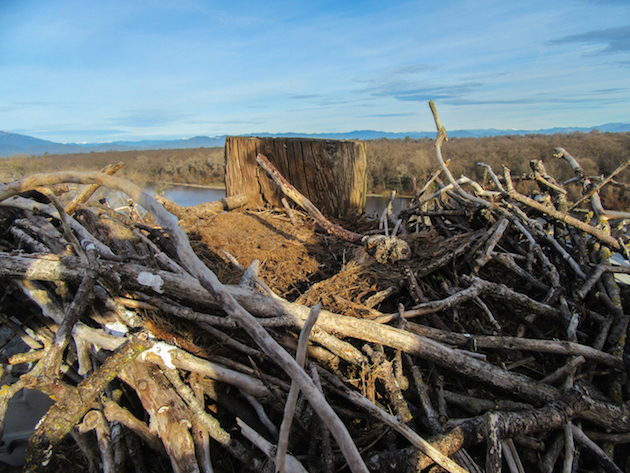
The shape of the Osprey nest changes during the breeding cycle. During incubation the nest is distinctly bowl-shaped. After hatching the nest flattens out, but a rim of sticks is maintained, sometimes by the young themselves, while the young are beginning to move clumsily about the nest. In the last weeks of the nestling phase, the nest often becomes completely flat1. Note the large sticks and bark.
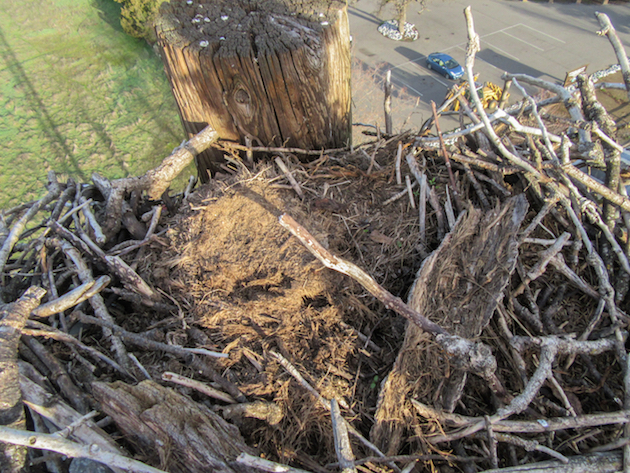
Here’s a shot of one of the installers placing the nesting material back into the newly installed nesting platform.
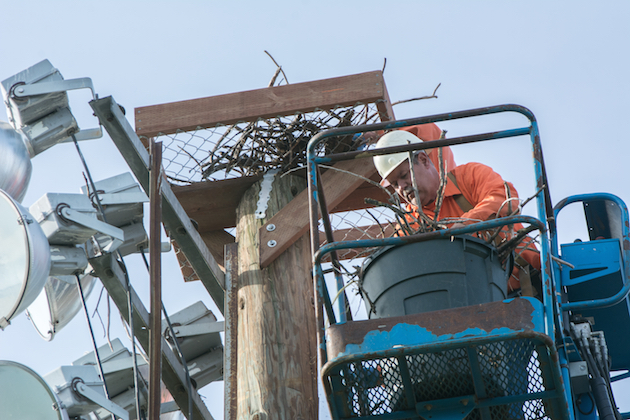
About four weeks after the install I went back to the park to see if Osprey had shown up. I found one bird perched inside the platform!
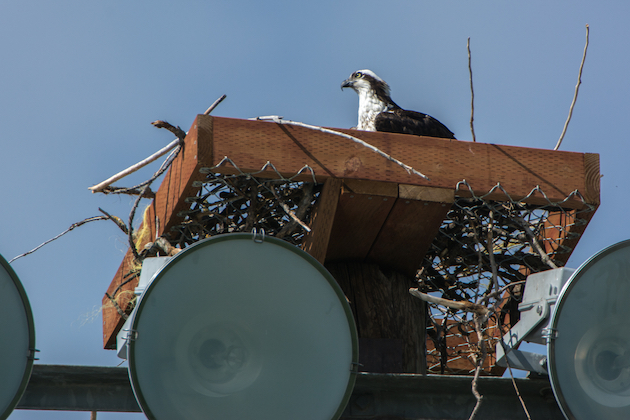
However, there were also a pair of very vocal Red-Shouldered Hawks (Buteo lineatusin) in a nearby tree.
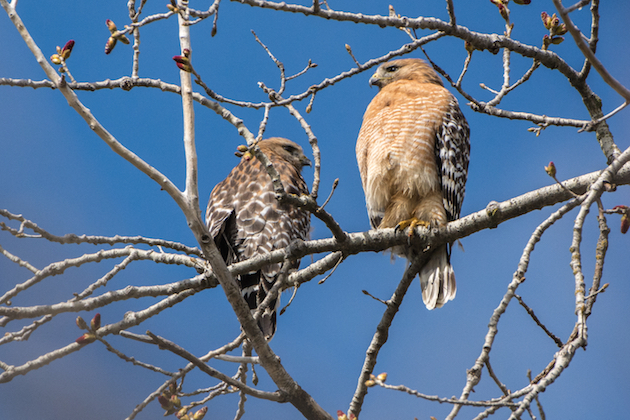
Apparently they were interested, for whatever reason, in the nesting platform as well.
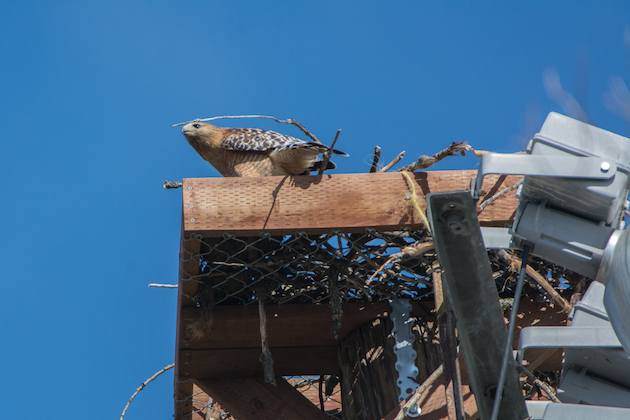
A week later when I returned, the platform was now occupied by a pair of Osprey!
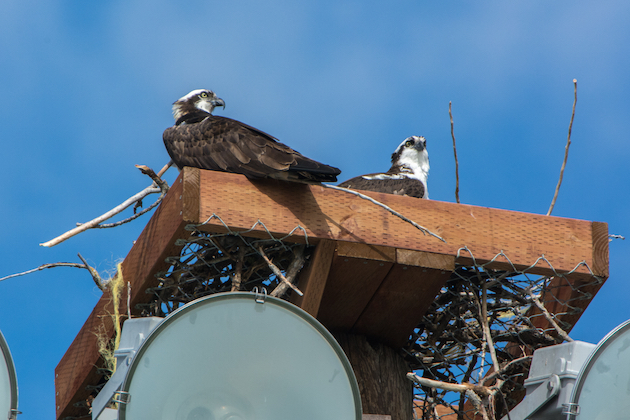
I observed them for over an hour but never saw them bring in nesting material, although there is obviously new sticks in the nest. The Red-shouldered Hawks were still hanging around but this day, the Osprey pair were involved in mating and the hawks were vigorously chased away by the male Osprey.
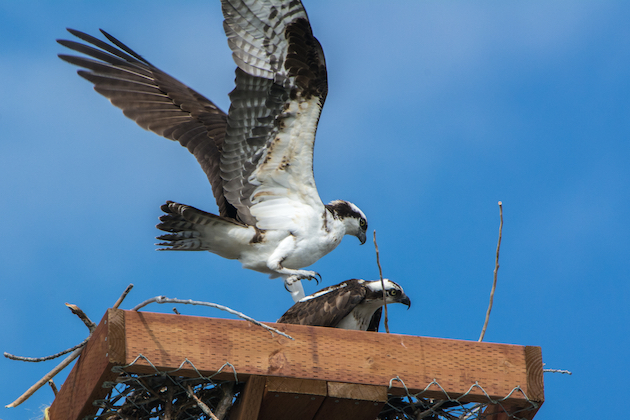
Osprey pairs copulate frequently, on average 160 times per clutch, but only 39% of these result in cloacal contact. Pairs average 59 successful copulations per clutch, starting 14 days before, and peaking a few days before, the start of egg-laying1.
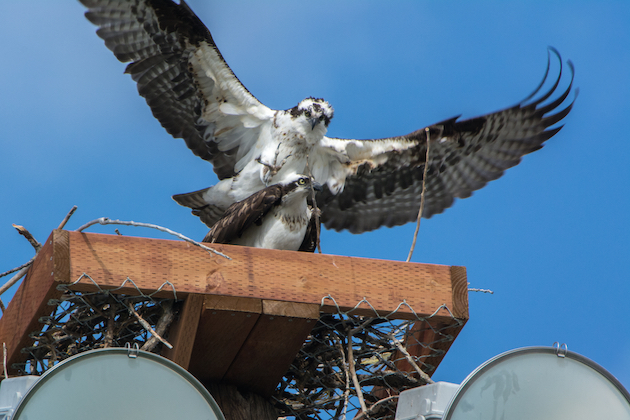
Pairs copulate most often in early morning, at the same time as egg-laying1.
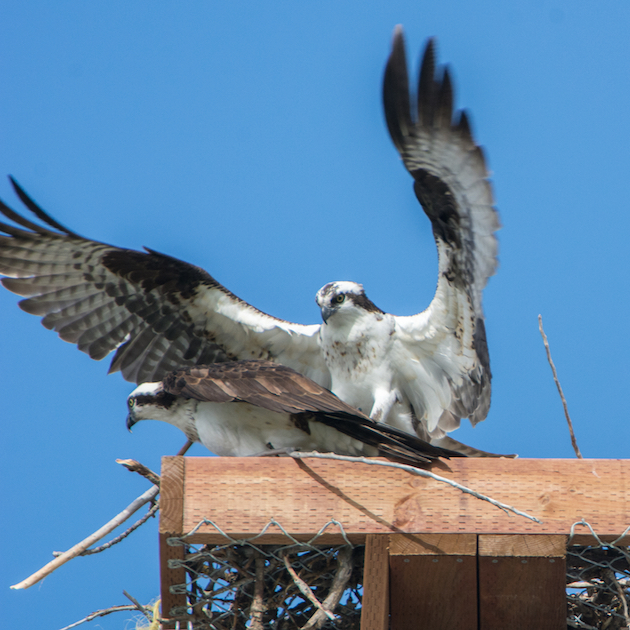
As I returned a couple of weeks later, the first thing I noticed is that there has been much more nesting material placed into the platform and the male was bringing in more and arranging the sticks.
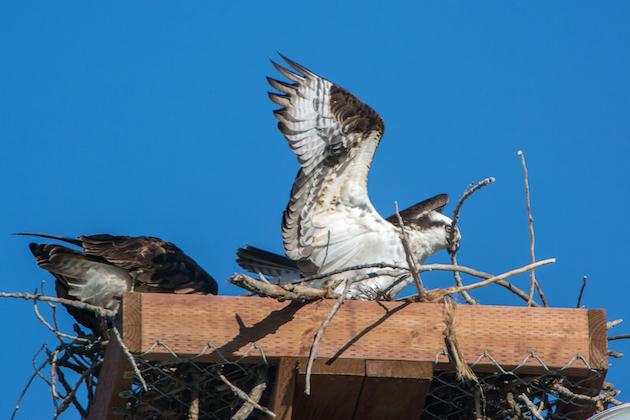
After trimming and arranging these large, long sticks, the male Osprey took off and the female did some rearranging.
The male soon returned to a nearby utility pole on the opposite side of the soccer field with a rather large, what looks like a trout.
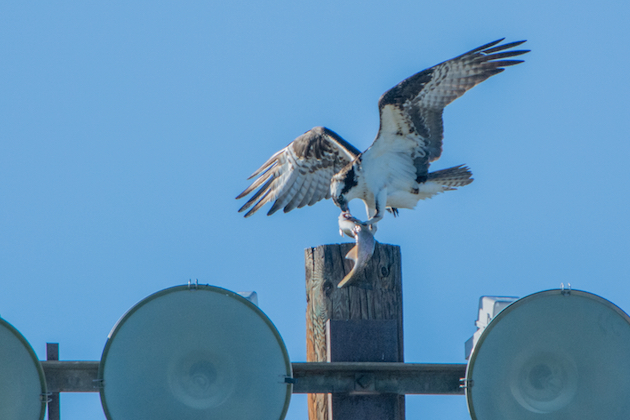
He ate about half of the fish, starting at the head, before carrying the remaining portion back to the platform to share with his mate.
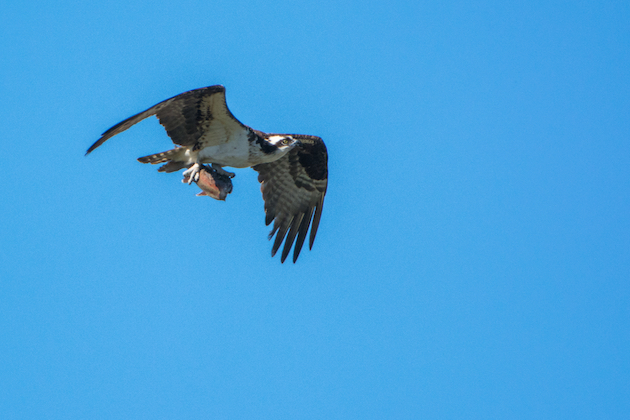
References: 1Birds of North America Online
Millville Plains Outing
Lewis’s Woodpecker, Western Bluebird and Horned Lark are a few of the usual species seen on this trip. Many raptors are possible including Ferruginous Hawk, Merlin and recently seen on Millville Plains Road, a Burrowing Owl! We will look for early migrants, possibly Western Kingbird and Tree Swallow, also Rock Wren on Ash Creek Road. We will meet at the Kutras Park parking lot at 8am to carpool or the corner of highway 44 and Millville Plains Road at 8:20. Bring a lunch for this full day trip. For more information call Larry Jordan at 949-5266.
Wintu Audubon Fall River Valley Outing
Always a high species number destination, the Valley is a great place to see wintering raptors, various waterbirds and Sandhill Cranes. Meet your leader Larry Jordan at the Redding Convention Center at 7:30 sharp to carpool. Be ready for a full day with a lunch and water. Dress for changing weather. East-county participants can join the group at either the Park and Ride at the intersection of Hwy. 299 and 89 at 9 am or the Fall River Vista at 9:30 am. Rarities are possible! Contact Larry for more information at 949-5266.
Birds Pull Out Their Winter Coats
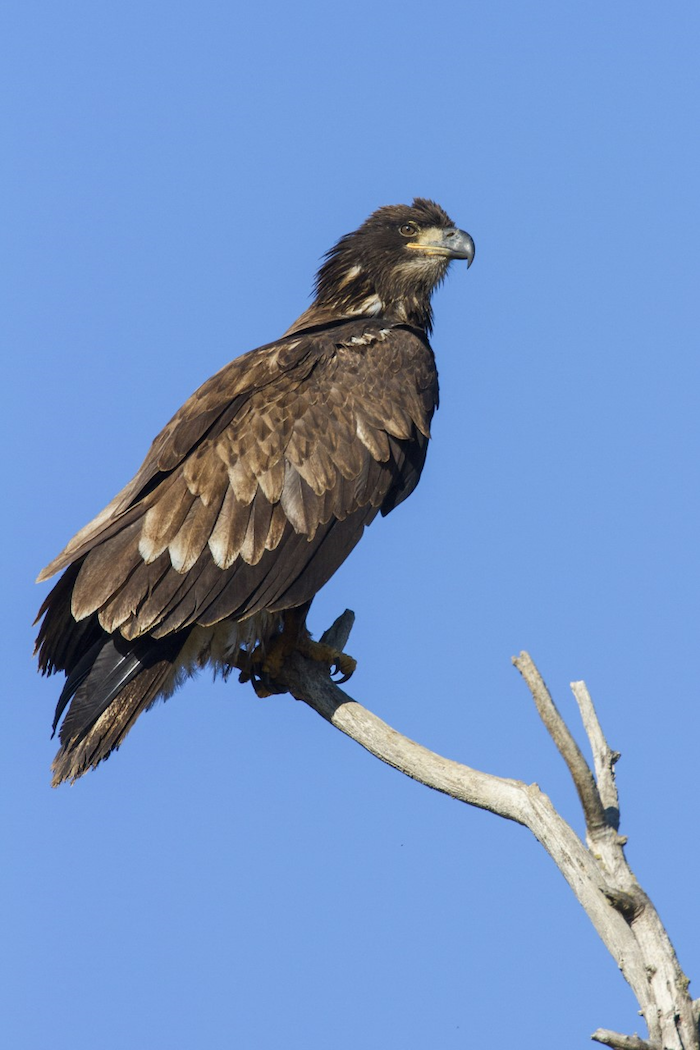
Bald Eagle Juvenile photo courtesy David Bogener
What’s up with our backyard birds? Where are they?
You may have seen them over the last months busily carrying load after load of insects to feed their ravenous nestlings, then being raucously pursued by fledglings demanding yet more food – sometimes with two or even three batches of babies through the season. All this effort has taken a toll on the adult birds’ feathers and now, despite the daily care they have taken preening and cleaning them, the feathers are worn out. The birds are lying low during their molt – the annual or twice yearly loss and regrowth of feathers done by most songbirds. But don’t expect to catch a glimpse of bald birds – each worn feather becomes loosened in its socket and is pushed out by the growth of a new feather.
The process takes from 5 to 12 weeks for songbirds, after which some will appear in winter plumage quite different from the bold patterns some males sport in summer. For example, American Goldfinch males are bright canary yellow with bold black accents during the breeding season, but become a quieter butterscotch color, much like females and juveniles, in their winter garb. Similarly, you may see a male Western Tanager that has lost his gaudy orange head feathers and exchanged them to the muted gray of a female before starting the long, dangerous migration to Costa Rica for the winter.
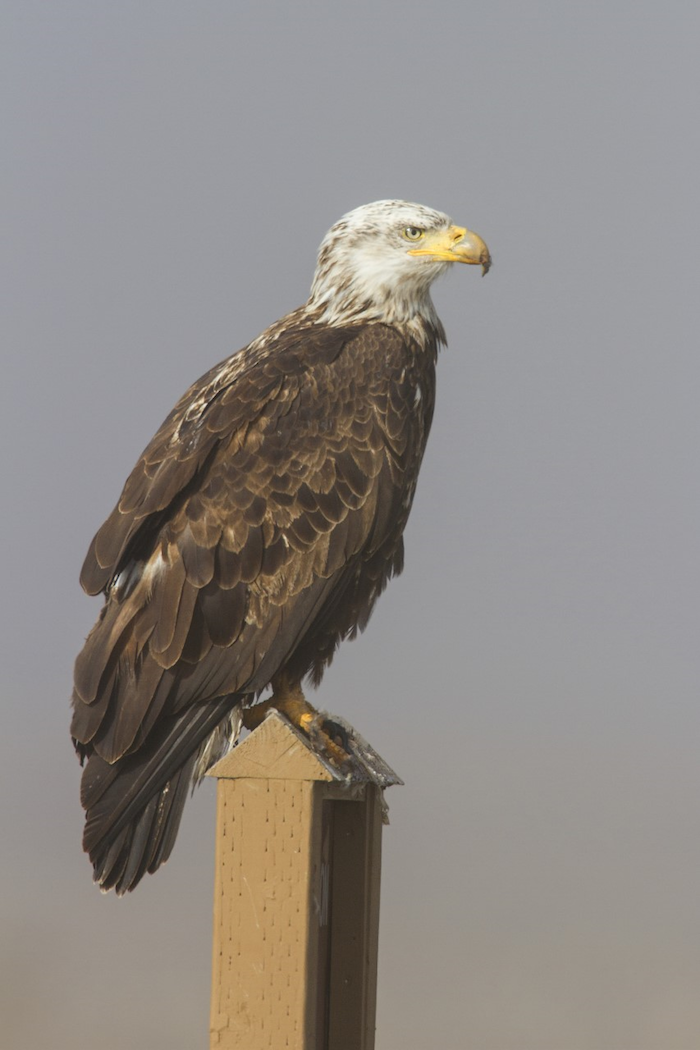
Bald Eagle Sub-Adult photo courtesy David Bogener
Other groups of birds go about the molt differently. Ducks, geese and some other water birds go through a rapid “synchronous molt”. They change their feathers quickly in a period as short as two weeks which renders them flightless for that period. This seems like a risky business – but researchers have deduced that since these birds are heavy relative to their wing surfaces, losing a few feathers at a time would seriously hamper flying ability, so they get it over with as quickly as possible and minimize the length of time that they are especially vulnerable to predators.
Raptors (eagles, hawks, falcons and their kin) “make their living” on the wing and can’t afford to suffer periods of impaired flying abilities. These birds may take as long as two years to complete a molt. The loss of flight feathers must be symmetrical or flying would be skewed. A woman who raised an owl that could not be released into the wild observed this in action. She reported that her feathered friend pulled a loose wing feather out and gave it to her, then immediately removed the corresponding feather from the other wing.
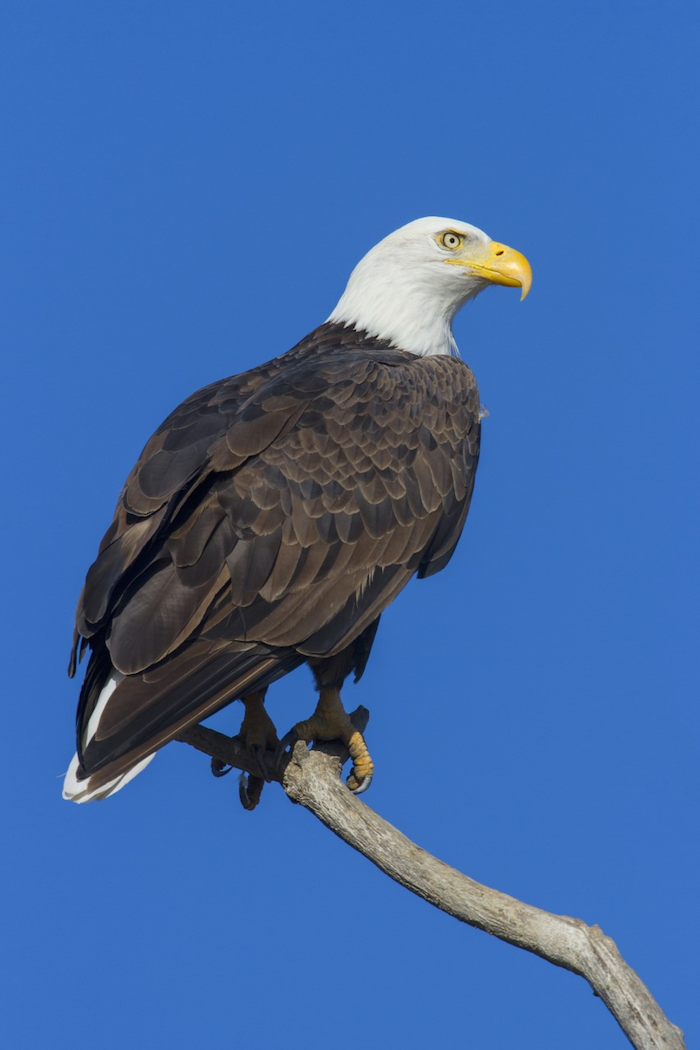
Bald Eagle Adult photo courtesy David Bogener
To give young Turkey Vultures a good start, they don’t molt their flight feathers until they are two years old. The vultures soaring over minus a couple feathers are almost certainly adults.
In most birds, tail feather replacement is from the center of the tail toward the outer edge. Woodpeckers reverse this for a very good reason. Watch closely the next time you see one ratcheting up a tree and you will see that it braces itself firmly using its stiff tail feathers. The key for this is an inner pair of long feathers. Those are retained until the outer tail feathers have been replaced with fresh, strong vanes, keeping the woodpecker able to fully function searching for insects in the bark.
You may find a single feather in your yard – evidence that one of “your” birds has cast it off for a brand new set of feathers to get it through the winter or prepare it to head off to winter habitat in Mexico, Central America or South America. Enjoy the memento!
